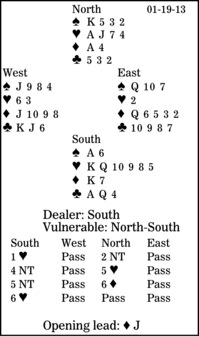Bridge column, January 19: The second chance is tough to see

Carl Jung said, "Your vision will become clear only when you can look into your own heart. Who looks outside, dreams; who looks inside, awakes."
At the bridge table, though, the opposite applies. If you worry only about your 13 cards, your partner will be dreaming of getting a new "third opponent."
This deal requires vision. How should South play in six hearts after West leads the diamond jack?
North's Jacoby two-no-trump response showed four-plus hearts and game-forcing values.
South starts with 11 top tricks: two spades, six hearts, two diamonds and one club. Probably his immediate reaction is to hope that the club finesse is working. Then he might think about eliminating diamonds and spades before trying to duck a club to West for an endplay.
However, declarer can do better. He should win the first trick with his diamond king, draw two rounds of trumps, play three rounds of spades (ruffing the last in his hand), return to dummy with a diamond, and call for the last spade.
Here, when East discards, South throws a club. West takes the trick but is endplayed. If he leads a club, it is into declarer's ace-queen. Or if he does something else, South ruffs in the dummy and sluffs his club queen.
If, though, East follows to the fourth spade, declarer ruffs, crosses to dummy with a trump, and ducks a club, hoping West will win the trick. But if East takes it and leads another club, South is forced to take the finesse.
** ** **
COPYRIGHT: 2013, UNITED FEATURE SYNDICATE
DISTRIBUTED BY UNIVERSAL UCLICK FOR UFS

